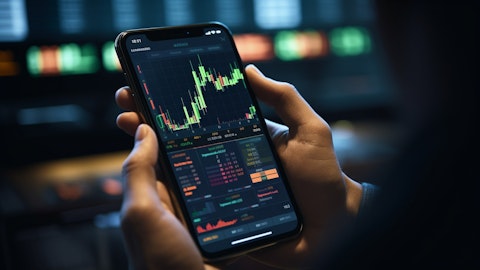And so we don’t — we won’t focus too much on that. I think any forecast for the MRO market any year, I think you could argue could be risk to the upside or downside, I don’t know. This is our current forecast, and we have economists internally and external that we look at, and this is the forecast they have right now. So that’s what we’re going with. But that too will always change and it will never be right until we know that. So again, we want to over-index on the forecast.
Deane Dray: Got it. And then for Dee or D G. either. The outlook for an expected increase in buybacks for 2024, the uptick there. Just what’s the expectation in terms of the pace of the buybacks through the year?
Deidra Merriwether: Yes. We’ve been fairly consistent for a number of years in our buyback practices generally under the vail of overall capital allocation strategy and we look to be in the market all the time based upon what the price of shares are. We don’t try to time the market from a price perspective, but always looking to be into the market buying shares. And so generally, we have pretty stable pace across the year for the share buybacks.
Operator: Our next questions come from the line of Christopher Glynn with Oppenheimer.
Christopher Glynn: Congrats on all the significant workplace culture recognitions, indicator of your durability. So I was curious what you’re seeing in terms of product cost deflation that you always try to drive as distinctive from, I think you called out, there’s some continuing benefits from the macro level supply chain normalization.
Deidra Merriwether: So this is the — we’ve gone from a as you know, over the last year or so a highly cost inflationary environment to something that is much more muted today — coming down today are much more reasonable or normalized is the term I would use is what we’re seeing. I would say, our product management team, utilizes the same sets of strategic and tactical activities with our supply base. We want to remain to be a customer of choice for them. And so we’re working to ensure that we continue to have advantage price and advantaged access to products at the best price possible. So things are getting to more normal level for us today.
Christopher Glynn: Great. And then on the B2C side of Zoro, I think you mentioned that the unwind there, the headwind would be first half weighted and suggest more neutral comps in the back half. So does that mean you’re exiting ’23 at about the sustainable mix?
Donald Macpherson: Yes. So I think what I would say there is that, obviously, as the B2C and B2C like volume shrinks, it becomes less of an impact on the rest of the business and our business customer activity has actually been reasonably healthy through the entire quarter. We do expect some of the decline to be less impactful in the back half of the year. So we should have less drag in the back half of the year than we have in the first half of the year from the decline B2C lifeline.
Operator: Our next questions come from the line of Ken Newman with KeyBanc Capital Markets.
Ken Newman: I know there’s a lot of moving pieces here, but I am wondering if you are seeing or have seen any impact from some of the [indiscernible] shipping dynamics and how are you thinking about shipping and screen expenses in ’24 and how that flows through your OpEx guide for the year?
Donald Macpherson: So on the Red Sea, we don’t have much volume going through that — those lanes. Most of our shipping volume comes out of Asia through to the West Coast and then as railed to our network. And so that has not been impacted. So we’ve really seen nothing there. Could you repeat the second half of your question? .
Ken Newman: Yes. Just curious, as a follow-up to that, how you’re thinking about freight expenses in general. I feel — I think most companies are seeing those kind of come up here? And how do you see that flowing through your OpEx line as it relates to your guide for the year? .
Donald Macpherson: Yes. I mean much of our freight, most of our freight actually goes into our gross profit line, but we — our forecasts haven’t changed much given the activity we’ve seen, given the lines we’re in. Certainly, things like fuel increases can have an impact and who knows how that’s going to play out. But right now, we’re actually still in a favorable position relative to a year ago — certainly on ocean freight at this point. So we expect that to continue through the first part of the year, and then we’ll see what happens.
Ken Newman: Got it. And then if I could just squeeze one more in here. I think you mentioned in the new framework that you expect Zoro and MonotaRO to kind of get back to that low teens type of growth range. It’s been a tougher couple of years here recently. As I think about the seasonality comments on the first half year kind of unwinding in the first half, is it reasonable to say, could you get back to that double — low double-digit range here within the back half of ’24? Or is that more of a 25% type of aspirational target?
Donald Macpherson: Yes, it’s probably more of a 25% — so to be clear, MonotaRO this year, we’ll be hitting that already, we think it’s low double-digit low teens. So that will be close to that for the year. And then Zoro will start the year lower than that, and we expect them to get a bit better as the year goes along. We probably won’t get there by this year, but that would be more in out years, we think that’s the target.
Operator: Our next questions come from the line of Patrick Baumann with JPMorgan.
Patrick Baumann: Just had a couple of questions for Dee on the price timing comments that you noted. Maybe if you could help us better understand first what you said with respect to Slide 13. Did the market take up price in the fourth quarter and you waited for the new year? Or was this something like in the comps that caused that disparity?
Deidra Merriwether: No. No. I think your — Slide 13, you’re kind of looking at what we have listed as what we think the market performance has been by quarter.
Patrick Baumann: It was about the fourth quarter, you had like you noted like a volume share gain of $475.
Deidra Merriwether: Yes. And so that difference is really that our price in the quarter was lower than the PMI print in the quarter. And so we were just highlighting for you that if you just look at the volume for IP versus our volume, then our share gain would have been 4.75. So there’s a difference in the market price as published today in Q4 versus what we realized from a price perspective. And the comments I was making earlier about timing is that our timing is not always going to be in line with the timing of price in the market. And this quarter was just one example of that. But you also have other examples if you look back over the course of several other quarters as we’ve outperformed the market. So we try to look at it on a 2-year stack, trying to get to neutral over a longer period of time.




